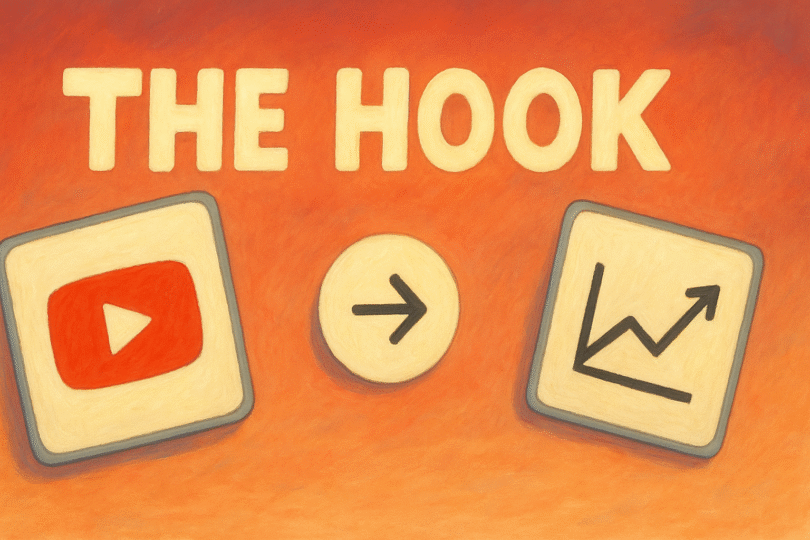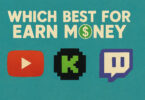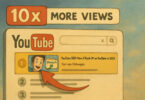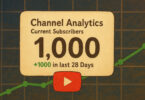Imagine spending hours creating the perfect YouTube video—researching, filming, editing—only to lose viewers in the first few seconds. It’s frustrating, right? That’s where the power of a hook comes in. In today’s competitive digital landscape, capturing attention immediately can be the difference between a viral hit and an overlooked upload. In this article, we’ll explore why a hook is important for YouTube videos , and how mastering this one element can dramatically improve your channel’s performance.
By the end of this guide, you’ll understand:
- The psychological impact of a strong hook
- How hooks influence YouTube’s algorithm
- Strategies to craft compelling intros that keep viewers watching
- Real-world examples of successful YouTubers who nail their hooks
Whether you’re a beginner or a seasoned creator looking to refine your content strategy, this article will provide actionable insights into leveraging hooks effectively.
What Exactly Is a Hook?
Before diving deeper into why hooks are essential, let’s define what they are. A hook in the context of YouTube refers to the opening segment of a video designed to grab attention within the first few seconds. This could be a surprising statement, a provocative question, a visual tease, or even humor.
Think of it like the trailer of a movie — its sole purpose is to entice you to watch more. On YouTube, where millions of videos compete for attention, a compelling hook serves as your first and most critical opportunity to make a lasting impression.
Why Is a Hook Important for YouTube Videos?
Now that we know what a hook is, let’s explore why a hook is important for YouTube videos . Here are several key reasons:
1. Improves Viewer Retention
YouTube’s algorithm heavily favors videos with high retention rates. If your audience watches only the first few seconds before clicking away, your video won’t rank well in search results or recommendations. A strong hook keeps viewers engaged from the start, improving overall watch time — a key metric for success on the platform.
2. Boosts Click-Through Rates (CTR)
Your hook doesn’t just matter once someone starts watching. Believe it or not, the way you present your video in thumbnails and descriptions also plays into hook psychology. A teaser-style title or thumbnail can act as a pre-hook, encouraging users to click and watch.
For example, titles like “You Won’t Believe What Happens Next” or “This Mistake Ruins Most YouTube Channels” create curiosity and drive clicks — which improves your CTR and signals value to YouTube’s algorithm.
3. Establishes Relevance Immediately
In a world full of distractions, viewers want to know quickly whether a video is worth their time. A clear and relevant hook communicates the value of your content upfront. If your intro answers the question, “What’s in it for me?” right away, viewers are more likely to stick around.
4. Sets the Tone for the Entire Video
A hook isn’t just about grabbing attention; it also sets expectations. Whether you’re going for informative, entertaining, or inspirational, your hook should reflect the tone and style of your content. This consistency helps build brand recognition and trust over time.
The Science Behind Hooks: Why They Work
Understanding the psychology behind hooks can help you craft more effective ones. Let’s break down the science:
Attention Span Statistics
The average human attention span has dropped from 12 seconds in 2000 to just 8 seconds today — shorter than that of a goldfish! This means creators have mere moments to capture interest before viewers move on.
Dopamine and Curiosity Gaps
Humans are wired to seek out novelty and resolve uncertainty. A well-crafted hook creates a curiosity gap — a disparity between what the viewer knows and what they want to know. This triggers dopamine release, making them want to continue watching to close the gap.
For example, saying something like “I tried this method for 30 days and saw shocking results” creates intrigue and motivates the viewer to stay until the reveal.
Types of Hooks That Work on YouTube
There’s no one-size-fits-all approach when it comes to hooks. Different types of content require different strategies. Here are some proven types of hooks that work across various niches:
1. Question Hook
Asking a direct question engages viewers by prompting them to think of their own answer. For example:
“Are you making this common SEO mistake that’s killing your rankings?”
2. Promise Hook
Offering a benefit or solution encourages viewers to stick around.
“Today I’ll show you how to double your YouTube views in just 7 days.”
3. Shock or Surprise Hook
Use a bold statement or unexpected fact to shock viewers into paying attention.
“95% of YouTubers don’t realize this change is coming — and it could hurt their channels.”
4. Story Hook
People love stories. Starting with a short personal anecdote pulls viewers in emotionally.
“Last week, I uploaded my biggest video ever — and it failed. Here’s why.”
5. Controversy Hook
Spark debate by challenging popular beliefs or norms.
“This advice is ruining your YouTube channel — here’s the truth.”
6. Visual Hook
Sometimes, visuals alone can serve as a hook. A fast-paced montage, dramatic scene, or eye-catching animation can stop the scroll.
How to Write a Strong Hook for Your YouTube Video
Crafting a powerful hook is part art, part science. Here’s a step-by-step guide to help you write compelling hooks every time:
Step 1: Know Your Audience
Before writing your hook, understand who you’re speaking to. What are their pain points, interests, and motivations? Tailoring your hook to your target audience increases relevance and impact.
Step 2: Focus on Value
Always lead with the benefit. Ask yourself: Why should someone care about this video? Make sure your hook clearly communicates the value they’ll get in the next few minutes.
Step 3: Keep It Concise
Avoid long-winded introductions. Get to the point quickly — ideally within the first 5–10 seconds. Every second counts!
Step 4: Use Emotion
Emotional appeals are more memorable than dry facts. Whether it’s excitement, fear, surprise, or humor, tap into emotions to connect with your audience.
Step 5: Test and Iterate
Not every hook will land perfectly the first time. Record multiple versions, test them with friends or early viewers, and see what resonates best.
How Hooks Impact YouTube’s Algorithm
YouTube’s algorithm is constantly evolving, but one thing remains consistent: watch time is king . And guess what drives watch time? You guessed it — a strong hook.
Here’s how hooks affect algorithmic performance:
1. Initial Engagement Metrics
When viewers watch more of your video from the beginning, YouTube interprets this as a signal that your content is valuable. As a result, your video is more likely to appear in suggested feeds, search results, and even the trending section.
2. Increased Average View Duration (AVD)
A good hook ensures people watch longer, which directly impacts AVD — another key ranking factor. Higher AVD means YouTube sees your video as engaging, leading to better visibility.
3. Improved Watch Time per Viewer
Even if two videos receive the same number of views, the one with better retention will perform better. A strong hook reduces bounce rate and increases the likelihood of viewers watching more of your content.
4. More Shares and Comments
Engaging hooks often spark reactions — likes, comments, shares. These social signals further boost your video’s authority in the eyes of the algorithm.
Real-Life Examples of Effective YouTube Hooks
Let’s look at some real-world examples from top creators who’ve mastered the art of the hook:
Example 1: MrBeast
MrBeast is known for his high-energy hooks that immediately draw viewers in. One of his most popular hooks:
“I’m giving away $1,000,000 to the person who finds this hidden camera.”
It’s exciting, creates urgency, and makes viewers want to stay tuned to see the outcome.
Example 2: Marques Brownlee (MKBHD)
Tech reviewer MKBHD uses a more professional yet equally compelling hook style. For instance:
“Apple just released the iPhone 16 — and it might be the most controversial upgrade yet.”
He creates intrigue by hinting at controversy, drawing in tech enthusiasts eager to learn more.
Example 3: PewDiePie
PewDiePie often uses humor and personality-driven hooks. A classic example:
“Okay guys, so I did something really stupid… again.”
His relatable and casual tone invites viewers to laugh along and continue watching.
These creators may come from different niches, but they all share one thing in common — they understand the importance of starting strong.
Common Hook Mistakes to Avoid
Even experienced creators sometimes fall into traps when crafting hooks. Here are some common mistakes to avoid:
1. Too Vague or Generic
Avoid hooks like “Hey everyone, today we’re talking about…” That’s boring and gives viewers no reason to stay.
2. Overpromising
Don’t promise something you can’t deliver. Overhyped hooks damage credibility and lead to higher bounce rates.
3. Too Long
Keep your hook short and punchy. Don’t waste time with unnecessary filler — get to the point fast.
4. Mismatched Tone
Make sure your hook matches the rest of your video. A serious hook followed by a comedic video can confuse viewers and reduce trust.
5. No Call-to-Action (CTA)
Some hooks end without guiding the viewer forward. Consider ending your hook with a soft CTA like “Stick around to find out…” or “Watch until the end to see what happened.
Tools to Help You Craft Better Hooks
If you’re struggling to come up with great hooks, there are tools and frameworks that can help:
1. Headline Analyzers
Tools like Advanced Marketing Institute’s Headline Analyzer score your headlines based on emotional impact, clarity, and curiosity.
2. AI Writing Assistants
Platforms like Jasper, Copy.ai, and ChatGPT can generate hook ideas based on your topic and niche.
3. Scriptwriting Frameworks
Use templates like PAS (Problem-Agitate-Solution) or AIDA (Attention-Interest-Desire-Action) to structure your hook effectively.
4. Hook Swipe Files
Create a collection of hooks from top creators in your niche. Study what works and adapt those principles to your own style.
How to Measure the Success of Your Hook
Once you’ve created a hook, how do you know if it’s working? Use these metrics to evaluate effectiveness:
1. Audience Retention Graph
Check your YouTube Studio analytics to see how many viewers drop off in the first few seconds. A sharp decline indicates a weak hook.
2. Average View Duration (AVD)
Compare AVD across videos. Higher AVD usually correlates with stronger hooks.
3. Click-Through Rate (CTR)
If your hook is reflected in your thumbnail or title, track CTR. High CTR + low retention = mismatched expectations.
4. Viewer Feedback
Pay attention to comments like “Loved the intro!” or “Didn’t expect that hook.” These insights offer qualitative feedback.
Final Thoughts: Why a Hook Is Important for YouTube Videos
To recap, a strong hook is not just a nice-to-have — it’s a must-have for any serious YouTuber. From boosting engagement and retention to signaling value to the algorithm, hooks play a foundational role in your video’s success.
Remember, your hook is your first chance to prove that your content is worth watching. Make it count.
Frequently Asked Questions (FAQs)
Q1: What is the ideal length for a YouTube hook?
A1: Ideally, your hook should last between 5–15 seconds. Anything longer risks losing attention.
Q2: Can I use the same hook for multiple videos?
A2: While some creators reuse successful hook formats, it’s best to tailor each hook to the specific video to maintain authenticity and relevance.
Q3: Should I include keywords in my hook?
A3: Yes! Including your primary keyword naturally in your hook can help with SEO and clarify the video’s purpose.
Q4: Do hooks work for all types of YouTube content?
A4: Absolutely. Whether you’re doing tutorials, vlogs, reviews, or educational content, a hook can enhance your video’s appeal.
Q5: How often should I update my hook strategy?
A5: Review your hook performance monthly and adjust based on analytics and audience feedback.
Conclusion: Master the Hook and Grow Your Channel
In conclusion, understanding why a hook is important for YouTube videos is essential for anyone looking to grow their presence on the platform. With competition fiercer than ever, a strong hook is your best tool for standing out, retaining viewers, and building a loyal audience.
Start experimenting with different hook styles, analyze your results, and refine your approach over time. The effort you put into crafting compelling hooks today will pay dividends in increased views, engagement, and long-term success.
So go ahead — hook your audience, keep them watching, and take your YouTube channel to the next level.








Leave a Comment